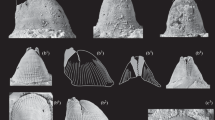Abstract
Shell chirality among Cambrian gastropods is discussed. It is demonstrated that the earliest members of the class include chiral aberrations with abnormal opposite coiling of the shell. It is assumed that, in Cambrian gastropods, speciation could have occurred by mutation in the locus determining the chirality, as is proposed for extant gastropods. In contrast to modern gastropods, the existence of chiral morphs within single species has not been recorded in Cambrian mollusks, whereas the presence of chiral twin species is possible. The systematic position of sinistral representatives of the genus Aldanella Vostokova, 1962 is considered. Aldanella golubevi sp. nov. with sinistral shell is described from the base of the Tommotian Stage of the Anabar Region. Aberrant sinistral specimens of the normally dextral species Aldanella utchurica Missarzhevsky in Rozanov et al., 1969 and Pelagiella adunca Missarzhevsky in Rozanov et al., 1969 are figured.
Similar content being viewed by others
References
D. A. Aleksandrov and S. O. Sergievsky, “A Variant of Sympatric Speciation in Terrestrial Mollusks,” in Mollusks: The Major Research Results (Nauka, Leningrad, 1979), pp. 153–154 [in Russian].
V. V. Anistratenko, “The Unique Type of Speciation by Formation of the ‘Mirror Forms’ (in Mollusca),” in Abstracts of the First Baikal Workshop on Evolutionary Biology (Limnol. Inst. Sib. Otd., Irkutsk, 2004), pp. 3–4.
T. Asami, “Evolution of Left-Right Asymmetry: Why Isn’t the Snail Mirror Flat?,” in Abstracts of the World Congress on Malacology, 2001 (Unitas Malacologica, Vienna, 2001).
T. Asami, R. H. Cowie, K. Ohbayashi, “Evolution of Mirror Images by Sexually Asymmetric Mating Behavior in Hermaphroditic Snails,” Am. Natur. 152, 225–236 (1998).
A. R. Bokova, “New Lower Cambrian Gastropods of the Siberian Platform,” Paleontol. Zh., No. 2, 123–126 (1990).
A. E. Boycott, C. Diver, S. L. Garstang, and F. M. Turner, “The Inheritance of Sinistrality in Limnaea peregra (Mollusca: Pulmonata),” Phil. Trans. R. Soc. London, Ser. B 219, 51–131 (1930).
A. Davison, S. Chiba, N. H. Barton, and B. Clarke, “Speciation and Gene Flow between Snails of Opposite Chirality,” PloS Biol. 3(9), 1559–1571 (2005).
Yu. E. Demidenko and P. Yu. Parkhaev, “Taxonomic Diversity of Early Cambrian Fine-Shell Faunas of China,” in Evolution of the Biosphere and Biodiversity: to the 70th Anniversary of A.Yu. Rozanova (KMK, Moscow, 2006), pp. 492–505 [in Russian].
E. Gittenberger, “Sympatric Speciation in Snails: A Largely Neglected Model,” Evolution 42(4), 826–828 (1988).
S. N. Golubev, “Ontogenetic Changes and Evolutionary Trends in the Early Cambrian Spiral Gastropods Pelagiellacea,” Paleontol. Zh., No. 2, 34–40 (1976).
J. R. Hendricks, “The Evolutionary History and Paleobiology of the Sinistral Cones,” in Abstracts of Denver Annual Meeting, 2002 GSA 34, 480 (2002).
M. S. Johnson, B. Clarke, and J. Murray, “The Coil Polymorphism in Partula suturalis Does not Favor Sympatric Speciation,” Evolution 44, 459–464 (1990).
V. V. Khomentovsky and G. A. Karlova, “Vendian-Cambrian Beds of the Dzhandy and Their Analogues in the Basic Sections of Eastern Siberia,” in Late Precambrian and Early Paleozoic of Siberia: Urgent Questions of Stratigraphy (Inst. Geol. Geofiz. Sib. Otd., Akad. Nauk SSSR, Novosibirsk, 1989), pp. 23–61 [in Russian].
V. V. Missarzhevsky, “The Earliest Skeletal Fossils and Stratigraphy of the Boundary Beds of the Precambrian and Cambrian,” Tr. Geol. Inst. Akad. Nauk SSSR, No. 443, 1–237 (1989) [in Russian].
A. R. Palmer, “From Symmetry to Asymmetry: mals and Their Evolutionary Significance,” Proc. Natl. Acad. Sci. USA 93, 14279–14286 (1996).
P. Yu. Parkhaev, “Functional Morphology of the Cambrian Univalved Mollusks—Helcionellids: Part 2,” Paleontol. Zh., No. 5, 20–26 (2001a) [Paleontol. J. 35 (5), 470–476 (2001)].
P. Yu. Parkhaev, “Molluscs and Siphonoconchs,” in The Cambrian Biostratigraphy of the Stansbury Basin, South Australia, Ed. by E. M. Alexander, J. B. Jago, A. Yu. Rozanov, and A. Yu. Zhuravlev (MAIK Nauka-Interperiodica, Moscow, 2001b), pp. 133–210.
P. Yu. Parkhaev, “Phylogenesis and the System of the Cambrian Univalved Mollusks,” Paleontol. Zh., No. 1, 27–39 (2002) [Paleontol. J. 36 (1), 25–36 (2002)].
P. Yu. Parkhaev, “Malacofauna of the Lower Cambrian Bystraya Formation of Eastern Transbaikalia,” Paleontol. Zh., No. 6, 9–25 (2004a) [Paleontol. J. 38 (6), 590–608 (2004)].
P. Yu. Parkhaev, “Helcionelloid Mollusks—Cambrian Dead End or the Foundation of the Gastropod Evolution,” in All-Russia Scientific School of Young Scientists Paleontologists on the Modern Russian Paleontology: Classical and New Methods (Paleontol. Inst. Ross. Akad. Nauk, Moscow, 2004b), pp. 53–55 [in Russian].
P. Yu. Parkhaev, “Cambrian Helcionelloid Mollusks As the Evolutionary Foundation of Gastropoda,” in Modern Russian Paleontology: Classical and New Methods (Paleontol. Inst. Ross. Akad. Nauk, Moscow, 2005), pp. 63–84 [in Russian].
P. Yu. Parkhaev, “On the Genus Auricullina Vassiljeva, 1998 and Shell Pores of the Cambrian Helcionelloid Mollusks,” Paleontol. Zh., No. 1, 20–32 (2006) [Paleontol. J. 40 (1), 20–33 (2006)].
A. Yu. Rozanov, V. V. Missarzhevsky, N. A. Volkova, et al., The Tommotian Stage and the Problem of the Lower Boundary of the Cambrian System (Nauka, Moscow, 1969) [in Russian].
J. Stone and M. Björklund, “Delayed Prezygotic Isolation Mechanisms: Evolution with a Twist,” Proc. R. Soc. London, Biol. Sci. 269, 861–865 (2002).
N. I. Vassiljeva, Small-Shell Fauna and Biostratigraphy of the Lower Cambrian of the Siberian Platform (Vses. Nauchno-Issled. Geol. Razved. Inst., St. Petersburg, 1998) [in Russian].
G. J. Vermej, “Evolution and Distribution of Left-handed and Planispiral Coiling in Snails,” Nature 254, 419–420 (1975).
Author information
Authors and Affiliations
Additional information
Original Russian Text © P.Yu. Parkhaev, 2007, published in Paleontologicheskii Zhurnal, 2007, No. 3, pp. 3–9.
Rights and permissions
About this article
Cite this article
Parkhaev, P.Y. Shell chirality in Cambrian gastropods and sinistral members of the genus Aldanella Vostokova, 1962. Paleontol. J. 41, 233–240 (2007). https://doi.org/10.1134/S003103010703001X
Received:
Issue Date:
DOI: https://doi.org/10.1134/S003103010703001X




